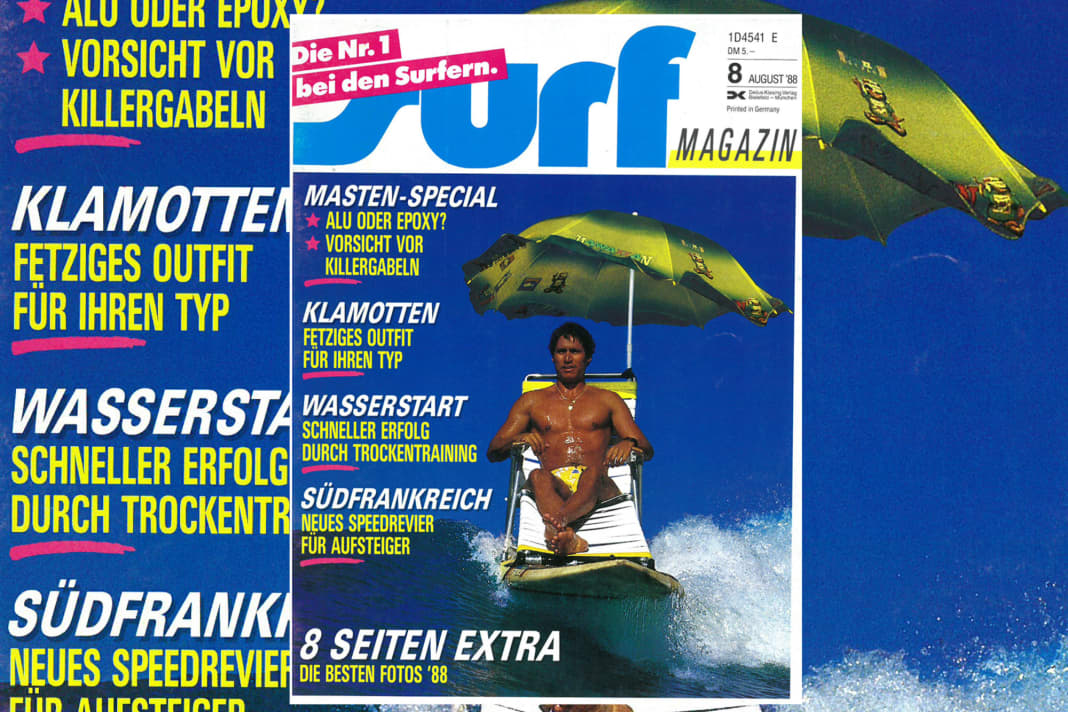





Undercover test in the surf shop
In 1988, the shop landscape was much more diverse than it is today; the shop was not just a pure point of sale, but often also a meeting place and lifestyle broker. surf anonymously scrutinised 23 shops and assessed their service, advice and display. Some showed serious deficiencies in their advice and neglected the "excess volume", i.e. the reserve for a sheet launch. Pearls from the consultations: "The sooner you start planing, the easier it is on your arms!", "The Bullitt can be surfed like a goat can be ridden!" or "If I ride the board, it's good for you too!". But the bottom line is that the quality of advice in the vast majority of shops is impressive!
Epoxy versus aluminium masts and "killer forks"
Today, aluminium masts are at most still acceptable for hoisting a flag of your favourite brand (or football club), but in 1988 they were considered expert material. In contrast to the buttery soft GRP spars, they were light, "lively" and provided top twist. Dunkerbeck, Naish and co. all raced with light metal. Robby also tried out a new aluminium model in the waves: "If I get hit by a wave, even a heavy GRP mast will break. The lighter aluminium mast allows a larger sail in gusty conditions, which means I can outrun threatening wave crests even in the wind hole." Carbon fibre masts were already available at the time, but were only of interest to professionals due to their high price.
surf also gets to the bottom of the causes of broken masts and finds out that the front pieces of the "folding forks" often crush the mast to such an extent that a predetermined breaking point is created. "90 per cent of all booms are mast killers," is the conclusion. One specialist even predicts: "The end of the folding fork era is in sight!" However, there is no alternative.
Surfer types in the character study
When it comes to fashion, the eighties are special anyway, as you can see when leafing through the magazine. Bright neon, screaming colours and adventurous hairstyles paint an impressive style picture of the era. Windsurfers as casual fun sportsmen often lead the way in terms of fashion, but the scene itself is also diverse. surf shows the different types of surfers and how they can be recognised. The Fanatic type finds "a three-megabyte hard drive just as exciting as three metres of ultra-carbon", while the Klepper type has opted for a brand "without any Hawaiian image", whose name is "colloquial German for a decrepit ungulate". The Mistral guy hasn't been on the water for a long time ("has started to think about buying a proper yacht"), while the Francophile Tiga rider goes out on the water even in sleet. The Windsurfing Chiemsee type, on the other hand, is ahead of his time and only finds windsurfing interesting on the Cape Verde Islands or in the Bering Strait.
The suffering of surfer women
"Women surfers - one of the underprivileged groups in this republic?" asks surf and shows a waiting beauty sitting on the shore in a lowered 190 and reading "Everything will be different with the next man" while her boyfriend/husband trudges into the (mirror-smooth) water. Various scenarios are sketched out: The lady of the heart is sandblasted in a storm, rudely reprimanded during her own attempts at surfing or left alone with the children. One psychologist states: "Surfing is a time-consuming hobby that is hostile to communication. It can often exacerbate existing problems in a marriage!" The solutions: Relaxed warm water spots instead of the cold Baltic Sea, professional surf instructors instead of over-ambitious friends and a clear division of family and surfing time.
And what else?
- Protection of the North Sea and preservation of surf spots: A card is enclosed in the envelope asking readers to sign and return it. Wording: "I undertake to show the greatest possible consideration for nature when practising my sport and to abide by the environmental rules for the behaviour of water sports enthusiasts [...]. However, I also demand that politicians at international level - if necessary single-handedly - do everything possible to stop the poisoning and pollution of the North Sea." The cards are to be collected and handed over to the Federal Environment Minister.
- The best pictures of the year should increase motivation, whether it's a loop attempt, a trip to Maui or the start of a regatta
- surf is campaigning for the abolition of compulsory life jackets on Lake Garda and is organising a round table. The responsible tourism ministry has announced that it will change the law - "within two to three months".
- Some leading manufacturers do not want to come to boot in Düsseldorf in 1989 - in protest against the "dealer bazaar" in the neighbouring hall.
- After a series of accidents, surf ensures that Fanatic defuses the pointed board noses of some models. But other manufacturers do not adhere to the DIN standard for surfboard noses either.
- Top trim systems are a new trend in the accessories sector. The (storm) sail is simply hooked onto the base plate and trimmed at the top of the mast using a special device.
- In the Ford wind tunnel, surf tests how much fuel consumption is increased by the surf plane on the car. The greatest air resistance comes from the roof rack, the load itself is then hardly a decisive factor.
Also interesting:
- These were the highlights in surf 4/1979
- These were the highlights in surf 4/1981
- These were the highlights in surf 9/1984
- These were the highlights in surf 8/1986
- These were the highlights in surf 4/1990
- These were the highlights in surf 3/1992
- These were the highlights in surf 4/1994
- These were the highlights in surf 7/1997

